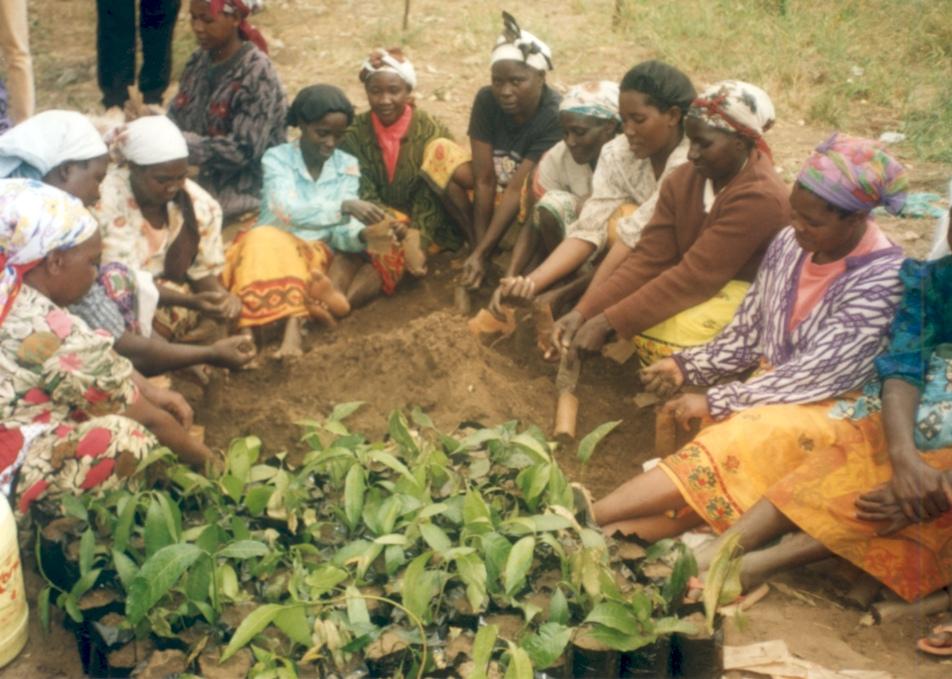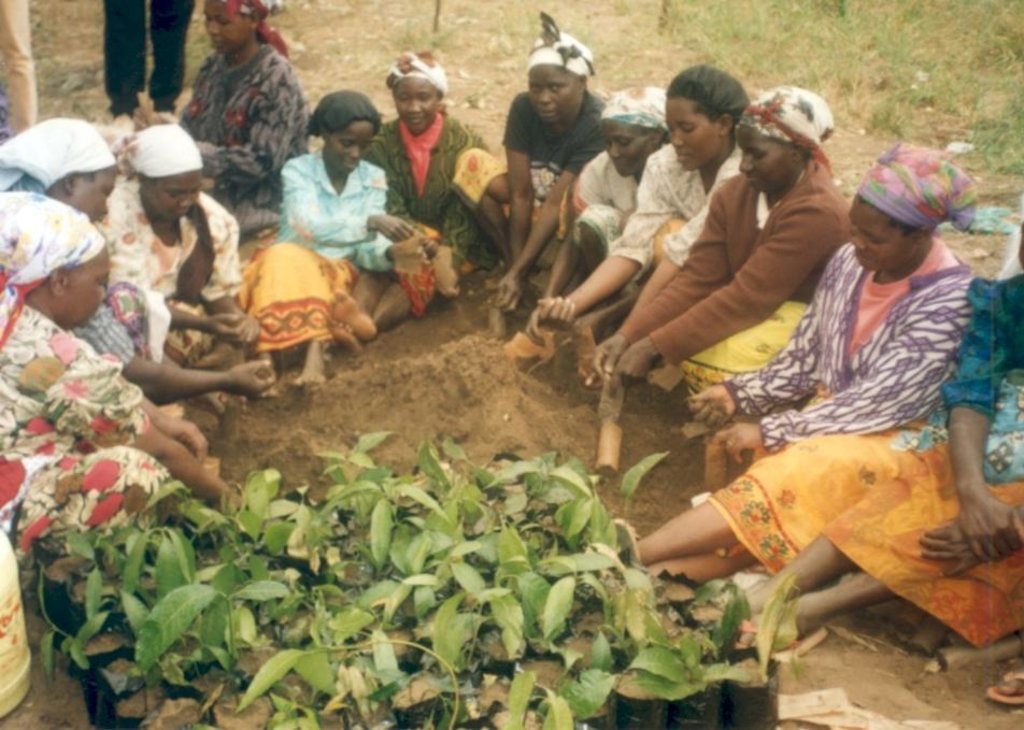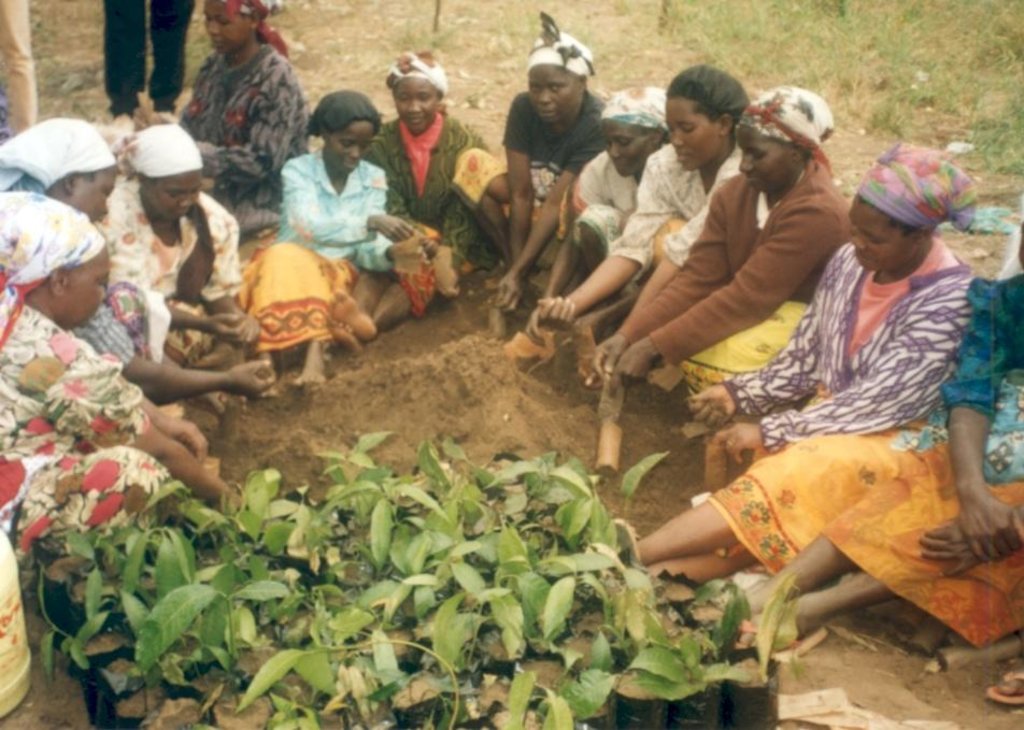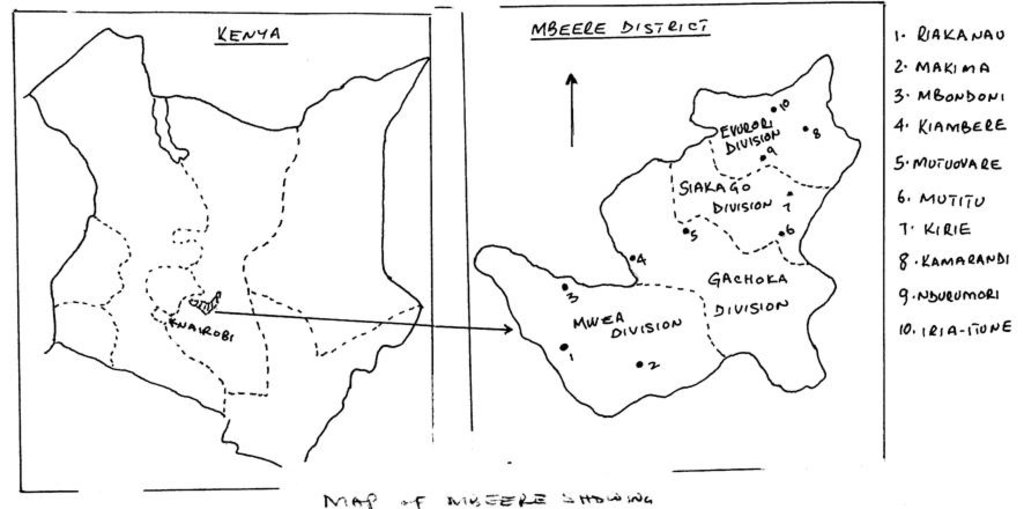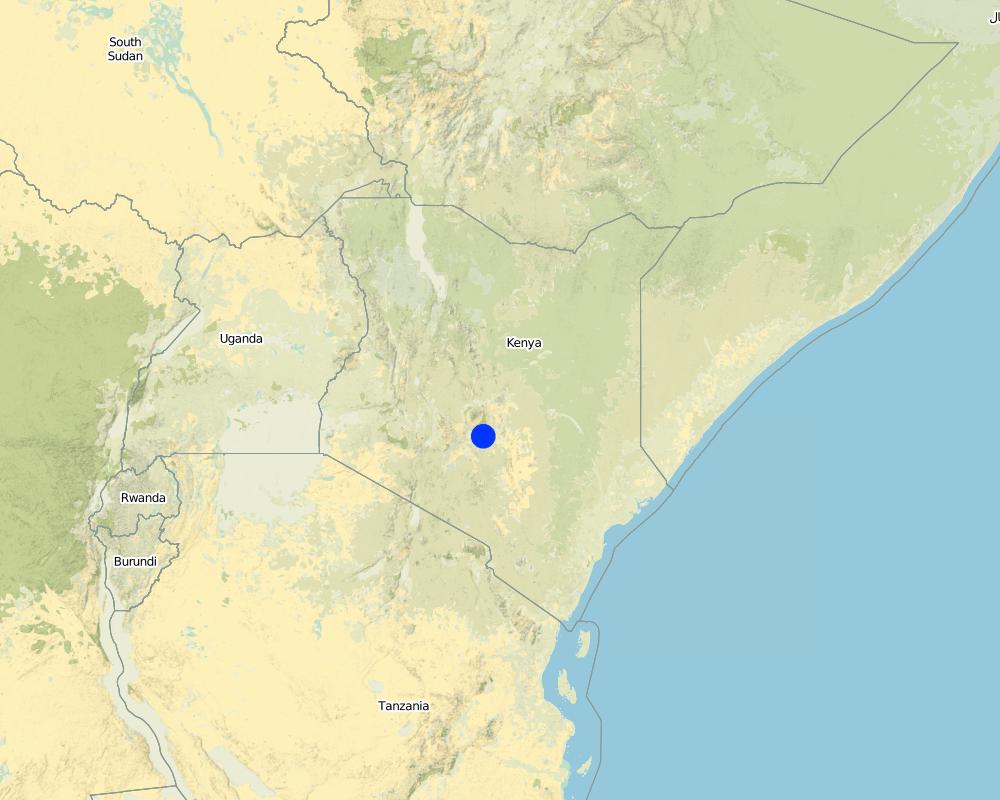Cash for Work [Kenya]
- Creation:
- Update:
- Compiler: Boniface, Mutegi Birichi
- Editor: –
- Reviewer: Fabian Ottiger
approaches_2360 - Kenya
View sections
Expand all Collapse all1. General information
1.2 Contact details of resource persons and institutions involved in the assessment and documentation of the Approach
SLM specialist:
Wamuyu Joseph
016120368
Diocese of Embu
Box 884
Kenya
SLM specialist:
Ireri Vincent
016120368
Diocese of Embu
Box 884
Kenya
Name of the institution(s) which facilitated the documentation/ evaluation of the Approach (if relevant)
Embu Diocese - Kenya1.3 Conditions regarding the use of data documented through WOCAT
The compiler and key resource person(s) accept the conditions regarding the use of data documented through WOCAT:
Yes
2. Description of the SLM Approach
2.1 Short description of the Approach
Giving cash incentives to farmers for them to undertake soil and water conservation
2.2 Detailed description of the Approach
Detailed description of the Approach:
Aims / objectives: Overall purpose of reducing vulnerability to famine and recurrent drought in Mbeere district. Specific objectives were to increase access to cash to meet basic needs of some 2000 most vulnerable households for a period of 4 months and to increase adoption of improved drought tolerant crop varieties for some 2000 most vulnerable households for aperiod of 9 months.
Methods: Methods of delivery were cash for work in construction of SWC structures including rural access road improvement and provision of access to planting seeds, technical knowhow and drought tolerant crop varieties.
Stages of implementation: Stages of implementation were sensitization and awareness creation of key stake holders and land users, Recruitment of technical staff and their training , selection of the beneficiaries and formation of groups ( 10 groups each comprising 20 farmers ) per work site, Election of focal area committees and their training, actual implementation of the agreed activities and finally monitoring and evaluation.
Role of stakeholders: Role of the participants was to provide labour, undertake good crop husbandry practices on the conserved land and participate in meetings, field days and group activities.
2.3 Photos of the Approach
2.5 Country/ region/ locations where the Approach has been applied
Country:
Kenya
Region/ State/ Province:
Mbeere Distict In Eastern Province
Map
×2.6 Dates of initiation and termination of the Approach
Indicate year of initiation:
2000
Year of termination (if Approach is no longer applied):
2002
2.7 Type of Approach
- project/ programme based
2.8 Main aims/ objectives of the Approach
The Approach focused mainly on SLM with other activities (*Water harvesting for crop productioin *Access roads improvement *Fruit trees establishment *Increased adoption of improved drought tolerant crop varieties)
*Increase access to cash so as to meet basic needs of the most vulnerable households *Consruction of soil and water conservation measures including improvement of access roads in the focal area ( work site ). *Increased adoption of improved drought tolerant crop varieties.
The SLM Approach addressed the following problems: * low land productivity due to soil erosion and drought *Migration of farmers to look for work during drouht speells *Poor access roads * Lack of seeds for improved drought tolerant crop varieties
2.9 Conditions enabling or hindering implementation of the Technology/ Technologies applied under the Approach
availability/ access to financial resources and services
- hindering
migration to look for off farm employment
Treatment through the SLM Approach: cash incentives to make the farmers remain in their farms and do conservation
legal framework (land tenure, land and water use rights)
- enabling
The existing land ownership, land use rights / water rights greatly helped the approach implementation: Individual land ownership encouraged the farmers to invest on their through various conservation efforts
knowledge about SLM, access to technical support
- hindering
Lack of adquate technical staff to lay out soil and water conservation measures
Treatment through the SLM Approach: Training work site (focal area) farmer commitees to do lay out work ie paraprofessionals.
other
- hindering
inadequate family labour on the farms
Treatment through the SLM Approach: Organise farmers into conservation groups ie communal work
3. Participation and roles of stakeholders involved
3.1 Stakeholders involved in the Approach and their roles
- local land users/ local communities
Working land useres where work is equally divided between men and women
The programme targeted the resource poor land users ie those that were already receiving food relief from the World food Programme (WFP).
- NGO
Diocese of Embu
- national government (planners, decision-makers)
Ministry of agriculture
- international organization
Catholic Relief Services (CRS)
3.2 Involvement of local land users/ local communities in the different phases of the Approach
| Involvement of local land users/ local communities | Specify who was involved and describe activities | |
|---|---|---|
| initiation/ motivation | passive | public meetings; Series of work site meetings to explain the programme to the land users |
| planning | interactive | Mainly: public meetings; partly: workshops/seminars; Workshops for key staholders held and training of the programme staff conducted |
| implementation | external support | Mainly: casual labour; partly: responsibility for major steps; Wor site committees were responsible for organising the farmers day to day activities |
| monitoring/ evaluation | interactive | Mainly: measurements/observations; partly: public meetings, reporting; Focal area committees were assisting the technical staff in taking measurements compiling reports |
| Research | interactive | on-farm; The mother (16 varieties ) and baby (3 varieties) trials were managed by the farmers |
3.4 Decision-making on the selection of SLM Technology/ Technologies
Specify who decided on the selection of the Technology/ Technologies to be implemented:
- mainly SLM specialists, following consultation with land users
Explain:
Consultative. Meetings were held with the land users where the activities to be undertaken were discussed and agreed on.
Decisions on the method of implementing the SLM Technology were made by mainly by SLM specialists with consultation of land users. Consultative. The method was chosen by the SWC specialists but discussed and adopted by the farmers
4. Technical support, capacity building, and knowledge management
4.1 Capacity building/ training
Was training provided to land users/ other stakeholders?
Yes
Specify who was trained:
- land users
- extensionists/trainers
Form of training:
- on-the-job
- farmer-to-farmer
Subjects covered:
Methods of soil conservation; Water harvesting for crop production; Lay out of soil conservation structures and tree planting
4.2 Advisory service
Do land users have access to an advisory service?
Yes
Specify whether advisory service is provided:
- on land users' fields
- at permanent centres
Describe/ comments:
Name of method used for advisory service: catchment (focal area) approach; Key elements: demonstrations, field days, trial plots and individual farm visits; 1) Mainly: government's existing extension system, Partly: projects own extension structure and agent 2) Mainly: government's existing extension system, Partly: projects own extension structure and agent; Extension staff: mainly government employees 3) Target groups for extension: land users; Activities: lay out work, agroforestry, individual tree nurseries establishment
Advisory service is quite adequate to ensure the continuation of land conservation activities; proramme used the existing extension staff within the focal areas. These staff arec still in place continously delivering extension services
4.3 Institution strengthening (organizational development)
Have institutions been established or strengthened through the Approach?
- yes, moderately
Specify the level(s) at which institutions have been strengthened or established:
- local
Specify type of support:
- capacity building/ training
- logistical surpport-transport
4.4 Monitoring and evaluation
Is monitoring and evaluation part of the Approach?
Yes
Comments:
technical aspects were regular monitored
economic / production aspects were regular monitored
area treated aspects were regular monitored by 0 through measurements; indicators: None
no. of land users involved aspects were None monitored by 0 through None; indicators: None
There were no changes in the Approach as a result of monitoring and evaluation: None
4.5 Research
Was research part of the Approach?
Yes
Specify topics:
- technology
Give further details and indicate who did the research:
adaptive onfarm trials carried out on new drought tolerant crop varieties
Research was carried out on-farm
5. Financing and external material support
5.1 Annual budget for the SLM component of the Approach
If precise annual budget is not known, indicate range:
- 100,000-1,000,000
Comments (e.g. main sources of funding/ major donors):
Approach costs were met by the following donors: international non-government (Catholic relief services): 99.0%; local community / land user(s) (Depreciation of farm tools): 1.0%
5.2 Financial/ material support provided to land users
Did land users receive financial/ material support for implementing the Technology/ Technologies?
Yes
If yes, specify type(s) of support, conditions, and provider(s):
In addition to the cash the land users were given seeds and fruit tree seedlings
5.3 Subsidies for specific inputs (including labour)
- equipment
| Specify which inputs were subsidised | To which extent | Specify subsidies |
|---|---|---|
| machinery | ||
| tools | ||
- agricultural
| Specify which inputs were subsidised | To which extent | Specify subsidies |
|---|---|---|
| seeds | partly financed | |
- infrastructure
| Specify which inputs were subsidised | To which extent | Specify subsidies |
|---|---|---|
| Community infrastructure | ||
Comments:
In addition to the cash the land users were given seeds and fruit tree seedlings
5.4 Credit
Was credit provided under the Approach for SLM activities?
No
6. Impact analysis and concluding statements
6.1 Impacts of the Approach
Did the Approach help land users to implement and maintain SLM Technologies?
- No
- Yes, little
- Yes, moderately
- Yes, greatly
incorporation of water harvesting techniques in crop production and manure application
Did the Approach improve issues of land tenure/ user rights that hindered implementation of SLM Technologies?
- No
- Yes, little
- Yes, moderately
- Yes, greatly
Did other land users / projects adopt the Approach?
- No
- Yes, little
- Yes, moderately
- Yes, greatly
The approach to spread to several other districts
6.3 Sustainability of Approach activities
Can the land users sustain what has been implemented through the Approach (without external support)?
- yes
6.4 Strengths/ advantages of the Approach
| Strengths/ advantages/ opportunities in the land user’s view |
|---|
| training (How to sustain/ enhance this strength: more field days and farmer tours) |
| provision of seeds and seedlings (How to sustain/ enhance this strength: setting up of bulking plots and group tree nurseries) |
| cash provision (How to sustain/ enhance this strength: intensify production of cash generating enterprises especially fruit trees like mangoes and pawpaws) |
| Strengths/ advantages/ opportunities in the compiler’s or other key resource person’s view |
|---|
| group approach (How to sustain/ enhance this strength: training of the committees, encourage more group activities and projects) |
| involvement and use of locally based extension staff |
6.5 Weaknesses/ disadvantages of the Approach and ways of overcoming them
| Weaknesses/ disadvantages/ risks in the land user’s view | How can they be overcome? |
|---|---|
| lack of appropriate tools | provision of suitable tools as the condition of the area dictate |
| Weaknesses/ disadvantages/ risks in the compiler’s or other key resource person’s view | How can they be overcome? |
|---|---|
| use of cash as incentive | should be phased out gradually |
| low land user involvement in the initial stages | use of participatory methods |
7. References and links
7.2 References to available publications
Title, author, year, ISBN:
Catchment planning- by E.Mwenda , MOA&RD-Nairobi
Mbeere district development plan 1997-2002
Links and modules
Expand all Collapse allLinks
No links
Modules
No modules


